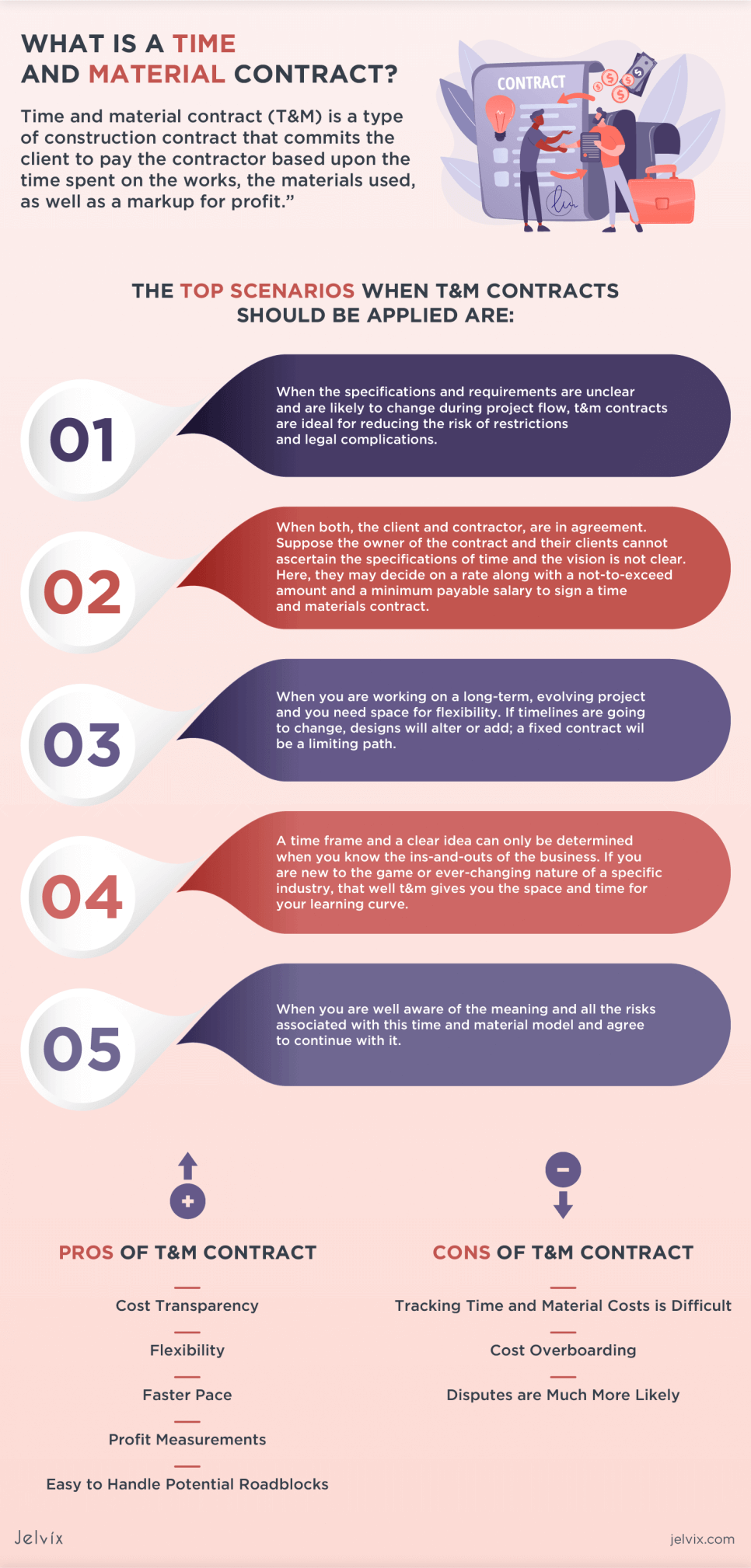Time and materials contract is a document that lets the client bill the project on the basis of the time taken and the cost of materials used.
T&M Contracts In Businesses
The world of business works on monetary value. Suppose you decide to outsource certain development, consulting, and professional services to create a product of your design. The agreement not only depends upon the price you are willing to pay and the method of payment. The right type of contract helps minimize risks and increase the chances of a positive outcome for both parties: the client and the development company. You could decide to pay a fixed amount or pay for the materials (effort) and actual time spent during the process.
So, where does time and material contract come into play? Well, the product’s monetary value is determined by two pillars – the quality and amount of time and effort it took to make it. So, it makes sense to charge the contractor in those terms.
T&M contracts in outsourcing can be considered as a special payment plan. It is a simple way for a client to track the work and time taken by a contractor to finish the project and decide on the final payment. It makes it easier to decide on the total price by factoring in the cost of materials and the total time spent working.
Traditionally, outsourcing contracts meant agreeing to a fixed price of payment. But now this new business-model of dealing with time-and-material is becoming more popular. There are a lot of factors to consider when choosing between the two models.
What agreement is best for you? When does time and materials contract make the most sense? How does it work? The pros and cons. To find the answer to these concerns, let’s talk about T&M Contracts in-depth and study their different aspects.
The What, When, and How?
-
What is a Time and Materials Agreement?
As defined by Designing Buildings Wiki, “Time and material contract (T&M) is a type of construction contract that commits the client to pay the contractor based upon the time spent on the works, the materials used, as well as a markup for profit.”
So, the contractor is paid for commercially reasonable efforts, and the time it takes to finish the project. We talk about T&M in terms of custom development, but it may be applied to any product development agreements or outsourcing contracts.
-
When Does It Make Sense?
T&M services are useful when the exact extent of a project cannot be determined accurately. When does this happen? These situations generally arise when the vision of the project is not clear, a fixed timeline is not created, in most long-term projects, the designs tend to change, and other similar scenarios.
The Complete Guide to T&M Contracts
Situations Where T&M Services Shine
The top scenarios when t&m contracts should be applied are –
- When the specifications and requirements are unclear and are likely to change during project flow, t&m contracts are ideal for reducing the risk of restrictions and legal complications.
- When both, the client and contractor, are in agreement. Suppose the owner of the contract and their clients cannot ascertain the specifications of time and the vision is not clear. Here, they may decide on a rate along with a not-to-exceed amount and a minimum payable salary to sign a time and materials contract.
- When you are working on a long-term, evolving project and you need space for flexibility. If timelines are going to change, designs will alter or add; a fixed contract will be a limiting path.
- A time frame and a clear idea can only be determined when you know the ins-and-outs of the business. If you are new to the game or the ever-changing nature of a specific industry, that well t&m gives you the space and time for your learning curve.
- When you are well aware of all the risks associated with this time and material model and agree to continue with it.
Items in a Time and Material Contract
There are a few important particulars that should be thoroughly discussed and clarified with the second-party involved in the agreement. These points are crucial for smooth-sailing, non-disruptive workflow between the contractor and client. They are also included in the total cost calculation and, thus, price determination of the project.
These particulars include –
- Labour Rates
The agreed hourly rate for manpower and other services for everyone working on the job, including project administrators.
- Markup
As posted by The Economic Times, the definition is “Markup refers to the value that a player adds to the cost price of a product. The value added is called the markup. The markup added to the cost price usually equals the retail price.”
So, in this case, the markup would be whatever the contractor pays to get the material, either from the market or by a predetermined seller. Since the contractor would be the one purchasing the supplies for the contractor, it is important to carefully negotiate the seller and the rates of each product along with the quantities required. Keeping records and tracking purchases is also part of the process.
- Not-to-Exceed
Even though the timeline and costs are not fixed at the time of the agreement, you may add a not-to-exceed clause on labor charges and the project’s time period to set a boundary. The contractor will then inform you of the costs and when the project limit is near. This puts a cap on expenses and keeps “contractor-efficiency” by letting him know that you will not pay beyond the cap-price no matter what.
- Maximum Labour Hours
The maximum number of labor hours can be clearly set in the contract. So, you won’t have to pay for any additional hours of work done by the laborers. The wages and hours will have to be per the legal dictation of the area. This helps keep the efficiency high and avoid the ‘lower efficiency, more money’ rule often involved in t&m contracts.
T&M vs. Fixed Price Contracts
Another type of outsourcing model’s contract is the Fixed Price Contract. It is the ‘traditional’ way of doing things and is still often used by businesses.
Using Wikipedia as a reference, because who doesn’t, “A fixed-price contract is a type of contract where the payment amount does not depend on resources used or time expended.” Or, in other words, the exact opposite of the t&m model.
As the name suggests, fixed-price contracts predetermine the total cost of project development by factoring in the various expenses involved. The client then pays the amount up-front, and the contractor is legally-bound to deliver. This model is most appropriate when the project is clearly defined, and the timeline is set. It also gives a sense of assurance instead of signing up for a ‘blank paycheck.’
When does a fixed price contract work:
- All requirements are known, and deadlines are set
- There is a limited or fixed budget
- MVPs
- In the case of a small project with a limited scope
- Waterfall project management
However, time and materials contracts work on the assumption that the costs cannot be predetermined at the time of drawing up the contract. And since they cannot know what the future expenses might be or how much they could end-up costing, a ballpark figure is the best hope, which cannot be used as a contract basis.
Pros & Cons of T&M Contract
As many advantages a time and materials contract can fetch for you, it has its drawbacks too. Some consider it too risky and describe it as “signing up for a blank cheque” instead of knowing the exact cost of production.
In reality, yes, a t&m contract can be a variable, but it’s not unpredictable. As discussed before, t&m agreements are the best option for long-term projects with flexibility and when timelines are not defined. Let’s look in detail at both the advantages and risks a time and materials contract involves making an informed decision that’s right for your business.
Pros of T&M Contract
- Cost Transparency
In matters of product development, cost transparency becomes a priority. T&M services make you keep track of billings during the whole development period. So, you are briefed on all invoices, including references to timesheet summaries that provide a description of the work performed with timesheets, leaving no room for fraud.
You can also measure the team’s progress with KPIs to stay on top of the whole process or have access to all task management systems. Time and materials contract makes the whole process cost transparent.
- Flexibility
The lesser number of legally-bound restrictions provide flexibility in the project roadmap. These unit-price contracts make it much easier to alter the scope of work and hours to put into a project. Especially for big-scaled, long-term projects that may call for additional requirements and dynamic adjustments due to analysis of the latest market tendencies or end-user feedback.
- Faster Pace
Since the final cost is calculated along the development process, the project can start right away per unit time. In fixed-price contracts, it can take several months, possibly even up to a year, varying according to the specification and size of projects to accurately calculate all the costs involved in the process, which delays the start.
- Profit Measurements
In these types of contracts, the contractors know they will be reimbursed for their losses and can work without any cost-cutting and budgeting additional expenses on support and frequent updates. In fixed-price contracts, the budget and deadlines have to be adjusted in that fixed amount, which leads to the rationing of the process.
- Easy to Handle Potential Roadblocks
Unexpected roadblocks and barriers tend to pop-up more often than not, which slows down progress. This contract lets us create a buffer in pricing to accommodate for annoying “speed-breakers” and continue-on with the minimum time lost.
Cons of T&M Contract
- Tracking Time and Material Costs is Difficult
Cost transparency is good in business. But keeping a record of every transaction requires a lot of patience and understanding from both sides of the parties. The contractor must send updates for each work performed, including every feature added. Regular project management interaction with the client ensures scope compliance and full understanding of the process.
- Cost Overboarding
A major pain point when considering Time and materials contracts is going overboard the expected budget. Before the project starts, a client gets an estimated amount of time, and the cost of the project, and release dates. More often than not, these estimations turn out to be wrong. And so, the project budget turns out to be several times over the original figure.
- Disputes are Much More Likely
The deep involvement of contractors and clients, constant updates, and questions and price negotiations are likely to cause friction and arguments to arise. This not only hinders the pace of the projects but also strained relations. It is not uncommon for these types of contacts to end up in lawsuits.
Accusations of not acting in good faith, lowballing estimates, clients running out of money to cover all the costs, etc., can spiral out and end up in courts. This is a major reason why people and businesses tend to stray away from t & m agreements. Once you find a reliable T&M contractor for your project, you could save costs and get rid of many problems.
FAQs
1. Is it a Cost Type Contract?
T&M contracts can be considered as a hybrid contract type of fixed-price and cost-reimbursement contracts. The United States Federal Transit Administration website explains that time and materials services calculate labor costs using fixed hourly billing rates (specified in the contract.) These rates will include wages, indirect costs, general and administrative expenses, and profit. The fixed price element to these is the fixed hourly billing rates.
They are also like cost-type contracts as labor-hours are flexible. Materials (efforts) are also billed at the market rates.
2. How is it Different From the Labor-Hour Contract?
T&M contracts and Labour-Hour contracts are for the most part the same in principle. Labor-hour agreements are a variation of time and materials contract, different in only one aspect. In these types of contracts, the materials (efforts) required are not supplied by the contractor.
3. When is the Payment Made?
The payments in time and materials contract can be discussed with the vendors. They can be split into a salary-model payment plan. This will require the employer to make payments on a daily, weekly, or monthly basis.
4. What Decision is Best for my Business?
The payment method (fixed or t&m) should always be in agreement with your business, the project at hand, and the resources you have. The time-and-material pricing basis only makes you pay for the actual hours of work being done, minus the mandated breaks. But, if you are short on resources and have a limited budget, it may not fit your project scheme as the costs almost always go above the estimated amount.
On the other hand, it fits with a flexible design. The risks should be carefully weighed, and then a final decision should be made after consideration.
The End-Point
Outsourcing has become a common method of conducting business in the IT sector. The contract is just another aspect of this new “trend.” In this complicated world of buying and selling, time and materials contracts are a type of agreement to simplify the payment process.
It is important to understand the pros and cons, weigh the risks, and your business’s resources to decide; what works for you? The time and materials contract template that brought success for one vendor may not do the same for you.
After years of outsourcing services, Jelvix has chosen the time and material model for the projects with the clear goal and dedicated development model for the projects where the client’s long-term, day-to-day collaboration is a must.
We hope that now you know what a time and materials contract is. After reading about the what, when, and hows of time and materials agreements, you are much closer to make your decision. For more information, you can always get in touch with Jelvix’s team to discuss related outsourcing opportunities.
Need a qualified team of developers?
Unlock new business opportunities with the first-rate dedicated development team.

















